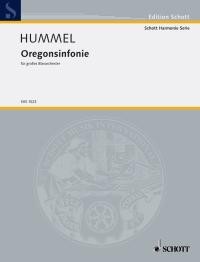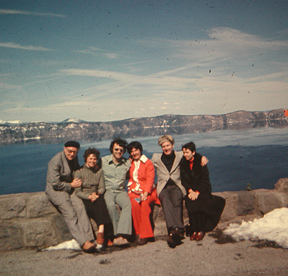Oregonsinfonie pour grand orchestre d'harmonie, op. 67 (1977)

I.
Ouverture ![]() début
début
II. Andantino
III. Adagio
IV.
Finale ![]() zone
médian
zone
médian
Première:
7 avril 1978, Monmouth (Oregon), Western Oregon University
Southern
Oregon State Symphonic Wind Ensemble / Max McKee
Instrumentation: flûte piccolo, flûte, houtbois, clarinette en mi bémol, 3 clarinettes en si bémol, clarinette basse en si bémol, basson, 2 sax.altos en mi bémol, Sax ténor en si bémol, Sax.baryton in en mi bémol, 3 trompettes en si bémol, 2 cors en fa, 2 trombones, tuba, tuba baryton en si bémol, tuba basse, contrebasse, percussion <5>
Durée: 23 minutes
Maison d'édition: Schott Music (partition et parties disponibles pour achat!)partition: ED 51871 SHS 1023 / parties: ED 51872 SHS 1023-50
Video: Hummel sur youtube
Non seulement très jouable mais pleine d'esprit, c'est ainsi que l'on peut caractériser la musique du compositeur Bertold Hummel, décédé en 2002. C'est bien la raison pour laquelle elle fait partie du répertoire des orchestres amateurs ou semi-professionnels. Hummel a écrit sa Symphonie de l'Oregon pour un orchestre à vents américain typique. Près de cent musiciens sont nécessaires à l'exécution : quinze clarinettes divisées en trois groupes de cinq, quatre piccolos et six flûtes, une clarinette basse, des bassons, es saxophnes, des trompettes, des cors, des tubas et un sousaphone, sans oublier cinq percussionnistes. L'oeuvre a quatre mouvements ; dans un finale plein d'entrain, Hummel mélange des motifs de jazz à des thèmes populaire et tisse tout à la fin dans sa musique l'hymne de l'Etat de l'Oregon. Le premier mouvement seul est également disponible ("Ouverture symphonique", SHS 1001)
The
Commissions Story
by M. Max McKee
Early in 1977, I was preparing to take a sabbatical leave from Southern Oregon College. I had decided to use the time to take a 6-week trip through several European countries with the intent of commissioning new works for band.
Because I had played Bertold Hummel's "Suite for Clarinet" on several occasions and liked it very much, he was one of my composer choices. Some of my saxophone students at SOC had played Ida Gotkovsky's "Brilliance," and this was another composition that caught my attention. I wrote letters to Hummel in Germany and Gotkovsky in France and sat back waiting for a response.
Five months passed. The day before the four of us left for Europe (my wife Nell plus my father and mother, George and Ona McKee) responses came from both composers through the college mail!! Had these arrived even one day later, the amazing connections in following years would never have occurred. (Meeting and working with Bertold and Ida were linked 12 years later to Philippe Langlet and Claude Pichaureau in France, Juan Mas Quiles of Spain, Kanat Akhmetov in Kasakstan, Georgy Salnikov and Igor Savinov of Russia and many more.)
During the 1977 European trip we stopped first to meet with Paris Conservatory composer, Ida Gotkovsky, at her Paris flat. Her husband, Marc Giullou, spoke good English and he helped us discuss the idea of writing a major composition for American bands. We immediately sensed a bond with them, Ida agreed to my paltry $500 offer for the commission and a few days later we were invited to their 200-year old home in Le Perray en Yvelines outside Pairs. It was only the beginning of a lifelong friendship.
Several weeks later we had made our way to Würzburg, Germany where Bertold Hummel served as President of the Hochschüle für Musik. Invited to his home, we once again fell into an immediate friendship with Bertold and his wife, Inken. A bit shaken from the look I got from Ida when offering the commission dollars in France, I started that conversation in my just-OK German with Bertold, "How much do you receive for your commission works?" He went on to tell me that most of his work outside of the conservatory was for West German Radio. "From them I receive $1000 per minute of music composed," he said.
After recomposing myself, I jokingly said, "Well, then, could you perhaps write me a 30-second composition? I have only $500 to offer." Bertold broke out with his infectious laugh and said, "For that, I can definitely write you something more than 30 seconds in length." The completed work that arrived mid-Summer of 1977 was a four movement, 26-minute symphony!
The end of story is even more amazing. Ida's Poeme du Feu (a 15-minute, 2-movement work) also arrived that summer. That and the Oregon Sinfonie provided a solid foundation for the SOC Wind Ensemble's program at the Northwest CBDNA in February 1978. It was at that point that I decided to make the entire program new commissions, new arrangements and special performances. My good friend and SOC colleague, Glenn Matthews, wrote Festival March. I made an arrangement of Wieniawsky's "Romance" from the Second Violin Concerto and featured another SOC colleague, violinist, Fred Palmer. The program ended with Alfred Reed conducting the West Coast Premiere of the "Armenian Dances, Part 2."

1978 Orgeon Crater Lake: Hummels - McKees - Marc Giullou / Ida Gotkovsky
Not only did Hummel and Gotkovsky compose the works for this special event, both traveled to America with their spouses paying their own expenses to join us for the 10-day period leading up to performances in the Salem area, at the CBDNA at Western Oregon College and at home in the SOC Music Recital Hall. Each spent time with the members of the band, traveled on the tour buses, visited our home on several occasions and enjoyed special trips to the Oregon coast and Crater Lake. It was a truly magical experience in so many ways. Little did I know that within a dozen years it would open up the world to our endeavors with Bandworld Magazine, Western International Band Clinic and, subsequently, the American Band College.